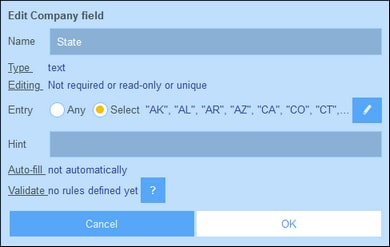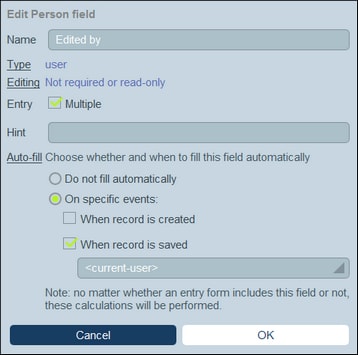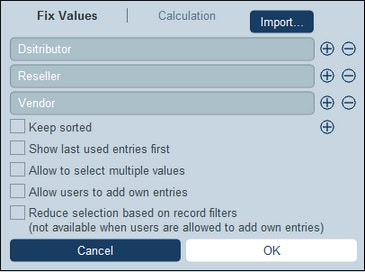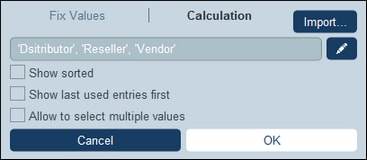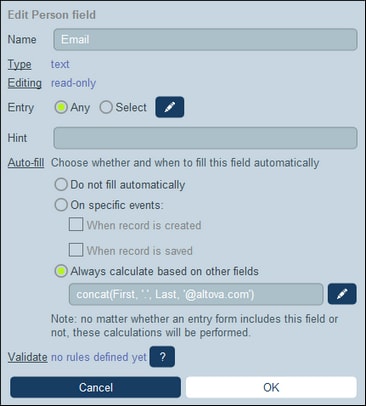Field Properties
In the Edit Fields form, if you click New Field or an existing field, the form for editing the properties of that field are shown (screenshot below). This form is the same for both new fields and existing fields. Field properties are described below the screenshot.
Name, Hint
Enter the name of the field and, optionally, a hint. The name of the field is a text string that identifies the field. The hint is a text string that will provide users with a hint about what the field is about and/or what kind of value can be entered for the field. For example, the State field shown in the screenshot above takes the abbreviation of a US state as its value. The hint could indicate this as follows, for example: Enter the state abbreviation (NY, AL, etc).
Type
Select the data type of the field (text, number, date, image, etc). For some fields, such as number and date, you must also additionally select a format. The Auto-increment number type is a number field that automatically increments the number (by a value you choose) for every new record. A Files type enables users to select a file for the field. An Images type enables users to select an image for the field. The following types have special system-related uses:
•Boolean: If you want the field to be editable, uncheck the Read-only option. If you want the field to always have a value, then check the Required option. If the Required option is selected, then you might want to also use the field's Auto-fill property. For the Entry setting, you must enter a value to display on Boolean true, and you can optionally enter a value to display for Boolean false. If the field is editable, then, in entry forms, the field will automatically be displayed with two radio buttons (for the user to select true/false) or with a check box (for selecting true; the unselected check box implies false).
•Auto-increment number: The field will hold an automatically incremented number. For each new record that is added to the current data table, this field will be auto-incremented by the increment you specify. You can choose to order records of the current data table in the context of their respective parent records in the parent data table or irrespective of their parents. This can be understood by considering the following situations. First, if the option to auto-increment within the parent is not selected, then each new record will be auto-incremented by the specified increment irrespective of whether the parent record is the same. Second, if the option to auto-increment within the parent has been selected, then as each new record is added, it will be ordered within the context of its particular parent record (not within the context of all parent records). Say, for instance, a record named Legal of a Department data table has been assigned to a record named Altova in the parent Company data table. This Legal Department record will be numbered in the context of its parent Altova company—and not in the context of all Department records. So, if the Altova record of the Company data table already has five Department records, then this new Legal record of the Department data table will be auto-incremented to six—even though it might be, say, the 97th record of the Department data table. Even if the Auto-increment number field is not shown in List forms, its ordering will determine the ordering of the list—unless some other field has been selected for initial sorting.
•Files: Enables one or more files to be attached to the field. For each file, the following actions are available: (i) view the file in the default file-type editor; (ii) save the file to any file location; (iii) reload the file to the field; (iv) delete the file from the field.
•Images: Enables one or more image files to be attached to the field. For each image file, the following actions are available: (i) view the image in the default image editor; (ii) save the image file to any file location; (iii) reload the image file to the field; (iv) delete the image file from the field.
•Reminders: Specifies that the field is a reminder field. If a data table contains no reminder field, reminders cannot be set for that data table. See Reminder Emails for details of how reminders are used.
•Link to: Creates a loose link to another data table in the system. Choose the data table you want to link to from the field type's combo box. For more information, see How the App's Data Is Structured, How Data Is Stored, and Database Structure.
•User: Enables the name of a system user to be entered as the field's value. This could be useful, for example, as shown in the screenshot below if you wish to have a field that records who last edited a field. If you want to allow multiple users to be entered in the field, then select the Multiple option. If the field is not filled automatically (via the Auto-fill option), then it would appear in entry forms as a combo box with a dropdown list containing the system's users. Note that each User has four properties: Name, Email, Group, and Role. In an entry form, you can choose which properties of the selected user/s to display. Also see XPath Expressions for more information.
Related features: Summary values, Grouping records on a date-type field, Reminder Emails.
Editing
Select whether the field is editable or read-only, and whether the value must be unique. If editing is required, then the field must not be empty: if empty, the record will not be saved. If the field is specified here as read-only, then it is read-only in all forms. To set the field as read-only in some forms only (not in all forms), leave Read-only unchecked here and select Read-only in individual forms.
Note the following: (I) multiple editing options are allowed; (ii) if Unique is selected, then Required is automatically also set.
Entry
Specify whether any entry is allowed for the field or whether the user must select from a list of entries. You can provide a list of entries and, optionally, allow users to enter their own values.
To allow users to enter values freely, choose the Any option. To specify a predefined list of entry choices, choose the Select option and then click the Edit icon. A form similar to that shown below appears. You can enter fixed values as shown in the screenshot below by adding a new row for each item (insert a row above an existing row or append a row to the last row). In the screenshot below, for example, there are three items (Distributor, Reseller, and vendor).
Alternatively, select the Calculation tab to enter an XPath expression that evaluates to a sequence of items. In the screenshot below, we use an XPath expression to generate the same list of items that we obtained by entering the values shown in the screenshot above. The XPath expression is: 'Distributor', 'Reseller', 'Vendor'.
As a third option, slick Import to import values from a CSV or XML file, or from the values already entered for this field. The imported values can replace or be appended to the values you added manually (in the rows).
From the list of options with check boxes, select any options you want:
•The multiple-values option enables the user to select more than one value.
•You can also allow users to enter their own values.
•If you have predefined a list of entry choices (and have not allowed users to enter their own values), then, for each filter of the data table, you can define a subset of the predefined list.
Alternatively, you can import the values of the entry list via a CSV file or XML file by clicking Import (see screenshot above). The CSV file must have a single column (with or without a header), which contains the items of the entry list. The XML file must have a root element and one repeating child element (where each child element contains an item of the entry list):
Auto-fill
Configure one of the following options (see screenshot below):
•The value is not filled automatically; users must supply the values
•Values are entered automatically when a record is created or when a record is saved. You can enter a fixed value or you can enter an XPath expression to dynamically calculate the value to enter. To edit the XPath expression, click the option's Edit icon (see note immediately below).
•Always auto-fill by calculating a value based on other fields of the data table. For example, in the screenshot below, we have calculated the value of the Email field by concatenating the values of the First field and Last field with a string constant: concat(First, '.', Last, '@altova.com'). To edit the XPath expression, click the option's Edit icon (see 'About editing XPath expressions' below).
If one of the Auto-fill options has been selected, then whenever a new field is added to the record or any field edited, you will be prompted about whether existing records of the data table should be updated. This is because the auto-filled value might have changed as a result of the added or edited field.
About editing XPath expressionsThe form for editing XPath expressions has three tabs: (i) Samples provides a random example of an XPath expression, such as: (a) the concatenation of three values (two values from other fields and a comma separator); or (b) an exists function to test whether a field contains some content; (note that the Samples tab might not be available in some situations); (ii) Fields lists the names of all the record's fields in alphabetical order so that they can be correctly entered in the XPath expression; (iii) Copy lists a selection of XPath expressions that contain various useful functions, which you can copy into your expression and modify.
See the section XPath Expressions for more information.
|
Validate
You can enter one or more predefined or self-defined validation rules. These enable the field value entered by the user to be validated before the record is saved. Note that you can enter multiple validation rules for each field. Additionally, you can set validation rules for the entire record. See Validation of Fields and Records for details.
